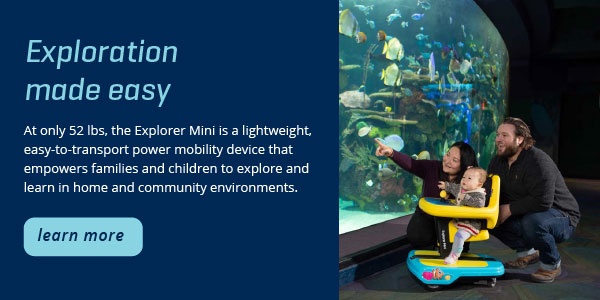Part 7 in our series about developmental milestones in early childhood focusing on mobility. See part 1, part 2, part 3, part 4, part 5, part 6, part 8, part 9, part 10, part 11, and part 12. Learn more about the Explorer Mini here.
The Explorer Mini is designed to be used by a wide variety of young children with mobility impairments. Children with physical disabilities who have difficulty achieving independent motor control are often deprived of opportunities for self-initiated or self-produced mobility. Mobility impaired toddlers who cannot move across a room to reach out and touch an object or interact with a person are at a great disadvantage. They can’t experience the sensorimotor and developmental activities of their peers who have achieved upright mobility, such as pushing and pulling toys, opening and closing drawers, or moving around and under objects.
Self-initiated mobility also affects motor functioning and the ability to develop mature grasp and postural control. Researchers who have studied the impact of early exploration on a child’s development have also suggested that self-produced locomotion and active choice are important for the development of perception and cognition (1).
Because self-produced, self-initiated mobility is intertwined—skills in concert with visual, cognitive, psychosocial, language and coordination—it is not possible to state that there is any pre-requisite skill that would predict a young child's acquisition or readiness to be successful or ready for the training in use of the Explorer Mini or any other power mobility device (PMD).
We can only look at typical developmental patterns and skills and suggest that the skills necessary for joystick interaction are a stable base of support, either by means of postural control or an external postural control seating surface. The joystick interaction is the means by which the device is designed to move. The child’s response to movement will prompt interaction with the device and with the act of mobility. It is the response to movement that contributes to the related aspects of language, postural response, and cognitive skills. Therefore, the skill set necessary to engage in self-initiated mobility by means of the Explorer Mini have not been established as no device has allowed us to investigate this.
Our best understanding is predicated on the work of conceptual thinkers and researchers who have demonstrated that mobility prompts the sensorimotor system to respond to the enhanced environmental exploration. Indeed, we know when a child is immobile for a period of time they lapse into a state of “visual idle”, wherein the visual system not being stimulated fails to orient or respond to the all too familiar and non-novel environment (8). Regarding the gross and fine motor skills necessary for safe use of the EM, we would highlight that these skills are developed as a result of mobility and not foundational skills that are necessary for interacting/ interfacing with the joystick or the movement of the device. To suggest that there are pre-requisites skills necessary to operate the EM would be presumptuous until such a device is available for clinical testing and ongoing use by children with mobility impairments.
Evaluation of children has traditionally focused on the achievement of developmental milestones. Underlying impairments such as motor control deficits cannot fully explain the extent and form of functional difficulties seen in children with disabilities. The tasks that are most relevant for daily independence in mobility function have not been well defined in traditional developmental milestone tests (10). We do however, have reliable and valid tools to assess posture of the infant (8). But as noted above posture alone or any motoric skills alone does not predict the infant’s ability to activate a joystick and begin the cascade of development that one would see in an infant capable of self-produced mobility.
If there are no pre-requisites, how can I know if it’s appropriate?
In light of the fact that there are no developmental tests that can predict a young child’s ability to operate the Explorer Mini, it’s important to understand that this does not negate the value of trialing a child in the device. Of the 34 children under the age of 36 months who participated in human factor validation studies of the Explorer Mini, 94% were able to move the device using the midline joystick control while 88% demonstrated cause and effect learning through grasping and releasing the joystick. And keep in mind, typically developing children don’t learn to sit unsupported or crawl without struggling through some initial failures to get to success. The same is true with the Explorer Mini. The key is to allow young children to try, and even struggle a bit to experience the success of self-initiated movement.
1. Acredolo, L.P., Adams, A., & Goddwyn, SW., (1984) The role of self-produced movement and visual tracking in infant spatial orientation. Journal of Experimental Psychology, 38, 312-327. Doi: 10.1016/0022-0965(84)90128-0
2. Anderson, D. I., Campos, J. J., Witherington, D. C., Dahl, A., Rivera, M., He, M.,… Barbu-Roth, M. (2013). The role of locomotion in psychologicaldevelopment. Frontiers in Psychology, 4(July), 440. https://doi.org/10.3389/fpsyg.2013.00440
3. Armstrong, W., Borg, J., Krizack, M., Lindsley, A., Mines, K., Pearlman, J., . . . Sheldon, S. (2008). Guidelines on the provision of manual wheelchairs in less resourced settings. Geneva, Switzerland: World Health Organization, WHO Press.
4. Butler, P. (1988). High tech tots: Technology for mobility, manipulation, communication, and learning in early childhood.Technology, Infants Young Children, 1, 66-73
5. Butler, P.B. (1998) A preliminary report on the effectiveness of trunk targeting in achieving independent sitting balance in children with cerebral palsy. Clinical Rehabilitation, 12, 281-293.
6. Butler C, Okamoto G and McKay T. Powered mobility for very young disabled children. Dev Med Child Neurology. 1983;25(4):472–474.
7. Butler C, Okamoto G and McKay T. Motorized wheelchair driving by disabled children. Arch Phys Med Rehabilitation 1984;65(2):95–97.
8. Higgins, C. I., Campos, J. J., and Kermoian, R. (1996). Effect of self-produced locomotion on infant postural compensation to optic flow. Dev. Psychol. 32, 836–841. doi: 10.1037/0012-1649.32.5.836
9. Lynch A, Ryu J, Agrawal S, Galloway JC. (2009) Power mobility training for a 7-month-old infant with spina bifida. Pediatric Physical Therapy.;21:362–368.
10. Mancini, M. C., Coster, W. J., Trombly, C. a, & Heeren, T. C. (2000). Predicting elementary school participation in children with disabilities. Archives of Physical Medicine and Rehabilitation, 81(3), 339–347. Retrieved from http://www.ncbi.nlm.nih.gov/pubmed/10724080
11. Paulsson K Christofferson M - 1986 - Psychosocial aspects of technical aids How does independent mobility affect the psychosocial and intellectual development of children with physical disabilities. pdf.
12. Ragonesi CB, Chen X, Agrawal S, Galloway JC. Power mobility and socialization in preschool: a case study of a child with cerebral palsy. Pediatric Physical Therapy. 2010; 22:322–329.
13. Stanton, D., Wilson, P.N., and Foreman, N. (2002). Effects of early mobility on shortcut performance in a simulated maze. Behavior Brain,136, 61-66. doi:10.1016/SO166-4328 (02)00097-9
14. World Health Organization. (2001) The ICF: An overview. Retrieved from https://www.wcpt.org/sites/wcpt.org/files/files/GH-ICF_overview_FINAL_for_WHO.pdf
15. Weisz JR (1979) Perceived control and learned helplessness among mentally retarded and nonretarded children: a developmental analysis. Developmental Psychology 15(3): 311–9470
 Dr Teresa Plummer, PhD, OTR/L, ATP, CEAS, CAPS
Dr Teresa Plummer, PhD, OTR/L, ATP, CEAS, CAPS
Associate Professor in the School of Occupational Therapy at Belmont University
Dr Teresa Plummer, PhD, OTR/L, ATP, CEAS, CAPS is an Associate Professor in the School of Occupational Therapy at Belmont University in Nashville, TN. She has over 40 yrs of OT experience and 20 in the area of Assistive Technology. She is a member of the International Society of Wheelchair Providers, and the Clinicians Task Force. She is a reviewer for American Journal of OT and guest reviewer for many other journals. She has presented internationally, nationally and regionally particularly in the area of pediatric power mobility. She has authored journal articles and textbook chapters in the area of OT and pediatric mobility and access.

